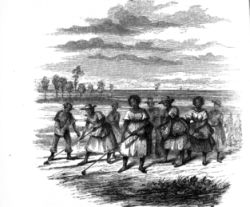
The Slaves' Midsummer Holiday, when enslaved laborers were permitted a few days off by their enslavers, occurred after crops were laid by and before harvesting began. On August 26, 1862 Catherine Ann Devereux Edmondston, a member of a significant planter-enslaver family of Halifax County, wrote in her diary that it was "the Negroes Midsummer holiday, and as all of them but Fanny & Dolly have gone down to the Plantation dinner, the premises are deserted." She referred to "the annual three days holiday" as if it occurred regularly. In sections of the South with large populations of enslaved people, summer was a likely time for a slave insurrection and one that white enslavers often dreaded for that reason. For example, the Nat Turner Rebellion at Southampton County, Va., occurred on Aug. 21, 1831.